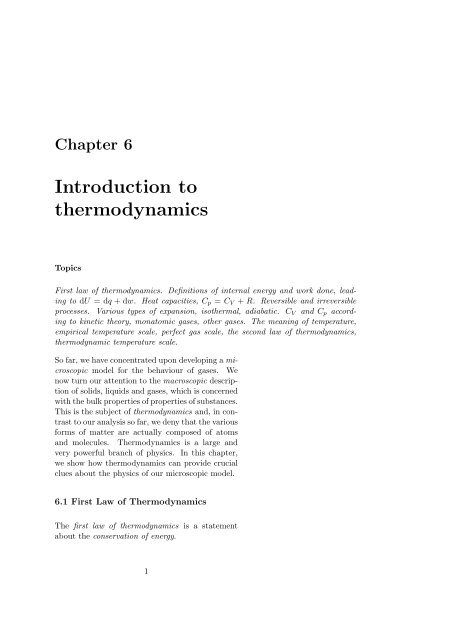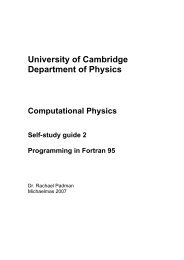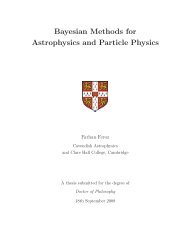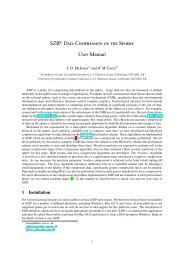Introduction to thermodynamics
Introduction to thermodynamics
Introduction to thermodynamics
Create successful ePaper yourself
Turn your PDF publications into a flip-book with our unique Google optimized e-Paper software.
Chapter 6<br />
<strong>Introduction</strong> <strong>to</strong><br />
<strong>thermodynamics</strong><br />
Topics<br />
First law of <strong>thermodynamics</strong>. Definitions of internal energy and work done, leading<br />
<strong>to</strong> dU = dq + dw. Heat capacities, Cp = CV + R. Reversible and irreversible<br />
processes. Various types of expansion, isothermal, adiabatic. CV and Cp according<br />
<strong>to</strong> kinetic theory, mona<strong>to</strong>mic gases, other gases. The meaning of temperature,<br />
empirical temperature scale, perfect gas scale, the second law of <strong>thermodynamics</strong>,<br />
thermodynamic temperature scale.<br />
So far, we have concentrated upon developing a microscopic<br />
model for the behaviour of gases. We<br />
now turn our attention <strong>to</strong> the macroscopic description<br />
of solids, liquids and gases, which is concerned<br />
with the bulk properties of properties of substances.<br />
This is the subject of <strong>thermodynamics</strong> and, in contrast<br />
<strong>to</strong> our analysis so far, we deny that the various<br />
forms of matter are actually composed of a<strong>to</strong>ms<br />
and molecules. Thermodynamics is a large and<br />
very powerful branch of physics. In this chapter,<br />
we show how <strong>thermodynamics</strong> can provide crucial<br />
clues about the physics of our microscopic model.<br />
6.1 First Law of Thermodynamics<br />
The first law of <strong>thermodynamics</strong> is a statement<br />
about the conservation of energy.<br />
1
Statistical and Quantum Physics 2<br />
Energy is conserved when heat is taken<br />
in<strong>to</strong> account.<br />
This is a somewhat more subtle statement than<br />
might appear at first sight. We have defined the<br />
heat capacity in terms of the amount of heat needed<br />
<strong>to</strong> raise the temperature of a substance by one degree,<br />
but we have not stated what heat is. The<br />
most rigorous approach is <strong>to</strong> define first of all the<br />
internal energy U of the system. We have already<br />
introduced this concept in our discussion of the internal<br />
energy of an ideal gas, but we can now generalise<br />
it <strong>to</strong> any substance or system.<br />
A material can s<strong>to</strong>re energy in many different ways<br />
besides molecular motions - the molecules may vibrate<br />
and rotate, the material may be placed in an<br />
electric or magnetic field, the energy density of radiation<br />
may be important and so on. Therefore, we<br />
need a general way of coping with all these possibilities.<br />
In general, there are two ways in which the system<br />
can acquire internal energy<br />
• We can do work on the system and so increase<br />
its internal energy.<br />
• We can allow heat Q <strong>to</strong> enter the system.<br />
The first statement is fundamental since it asserts<br />
that, by doing work on the system alone, we can<br />
raise the internal energy <strong>to</strong> any given value, quite<br />
independent of what we might mean by heat. This<br />
is the clue <strong>to</strong> how we define what heat is. We write<br />
down the expression for the change in internal energy<br />
due <strong>to</strong> both causes.<br />
dU = dQ + dW, (6.1)<br />
where dW is the work done on the system. This<br />
expression is a formal statement of the first law of<br />
<strong>thermodynamics</strong>.<br />
Note how we interpret this statement. The internal<br />
energy U is a well-defined physical quantity which<br />
we can measure. The amount of work done dW can<br />
The first law of <strong>thermodynamics</strong><br />
dU = dQ + dW
Statistical and Quantum Physics 3<br />
be measured also. We define the heat entering the<br />
system dQ <strong>to</strong> be the quantity<br />
dQ = dU − dW. (6.2)<br />
This may look like a slightly back-<strong>to</strong>-front definition<br />
of heat, but it is logically self-consistent.<br />
Now consider the case of a gas filling a cylinder<br />
with a pis<strong>to</strong>n. Figure 6.1 shows the force exerted<br />
by the gas on the pis<strong>to</strong>n, F = pA, where A is the<br />
surface area of the pis<strong>to</strong>n. Suppose now that the<br />
pis<strong>to</strong>n moves a tiny distance dx under the influence<br />
of F . Then, the work done by the gas is<br />
Work done = F dx = pA dx = p dV. (6.3)<br />
Since the gas is doing work, this energy must be<br />
abstracted from the internal energy of the gas U.<br />
Notice the importance of the signs in this calculation.<br />
If dV is positive, there is a loss of internal<br />
energy from the gas. Therefore, the expression for<br />
the change of internal energy of the gas dU is<br />
dU = dQ − p dV. (6.4)<br />
If dV is negative, the volume decreases and work is<br />
done on the gas.<br />
Now let us consider the expansion of one mole of<br />
the gas under conditions of either constant volume<br />
or constant pressure.<br />
Constant volume In this case, dV = 0 and so<br />
� �<br />
∂Q<br />
dU = dQ =<br />
∂T<br />
dT = CV dT, (6.5)<br />
where CV is the molar heat capacity at constant<br />
volume, which we have already introduced.<br />
V<br />
Constant pressure Work is done by the gas as<br />
it expands at constant pressure and so more heat<br />
dQ has <strong>to</strong> be supplied <strong>to</strong> provide the same increase<br />
in temperature. From (6.3)<br />
But dU = CV dT and so<br />
dQ = dU + p dV. (6.6)<br />
dQ = CV dT + p dV. (6.7)<br />
Figure 6.1. The cylinder and pis<strong>to</strong>n.<br />
p, V, T<br />
←−−− x −−−→ dx<br />
.<br />
.<br />
.<br />
.<br />
.<br />
.<br />
.<br />
.<br />
.<br />
.<br />
.<br />
. ................................................................................................................<br />
. . .<br />
. . . . .<br />
.............<br />
. . . . . .<br />
. . . . . .<br />
. . . . . .<br />
.............<br />
. . . . . .<br />
A<br />
F<br />
. . . . . .<br />
. . . . . .<br />
.............<br />
. . . . . .<br />
. . . . . .<br />
..<br />
. . . . . .<br />
. . . . . .<br />
.<br />
.............<br />
. . . . . .<br />
. . . . . . .<br />
. . . . . . . .<br />
..............................................................................................................................................................................................................................................................................................<br />
.........................<br />
.............<br />
. . . . . . . . .<br />
. . . . . . . .<br />
. . . . . .<br />
.............<br />
. . . . . .<br />
. . . . . .<br />
. . . . . .<br />
. . . . . .<br />
.............<br />
. . . . . .<br />
. . . . . .<br />
. . . . . .<br />
.............<br />
. . . . . .<br />
. . . .<br />
. .<br />
.............<br />
.<br />
.............<br />
.............<br />
. . .<br />
. . . . .<br />
. . . . .<br />
. . . . .<br />
. . . . .<br />
. . . . .<br />
. . . . .<br />
. . . . .<br />
. . . . .<br />
. . . . .<br />
. . . . .<br />
. . .<br />
Heat capacity at constant volume<br />
� �<br />
∂Q<br />
dU = dT = CV dT<br />
∂T<br />
V
Statistical and Quantum Physics 4<br />
We can now use the equation of state of the perfect<br />
gas <strong>to</strong> determine the change in volume at constant<br />
pressure,<br />
Therefore,<br />
pV = RT, p dV = R dT. (6.8)<br />
dQ = CV dT + R dT. (6.9)<br />
We can therefore find the heat capacity at constant<br />
pressure,<br />
� �<br />
∂Q<br />
Cp = = CV + R. (6.10)<br />
∂T p<br />
This is the famous relation between the molar heat<br />
capacities at constant pressure and constant volume<br />
Cp − CV = R. (6.11)<br />
6.2 Reversible and Irreversible Processes<br />
We need <strong>to</strong> introduce an important, but subtle,<br />
idea here. We are interested in how a thermal system,<br />
such as an expansion, evolves from one state<br />
<strong>to</strong> another and hence how much work is done on or<br />
by the system and how much heat is exchanged<br />
with the surroundings. However, our picture is<br />
based upon systems in thermodynamic equilibrium<br />
at a particular temperature. We need <strong>to</strong> be careful<br />
about using these concepts when the system evolves<br />
from one state <strong>to</strong> another. This is where the concept<br />
of reversible processes plays a key role.<br />
We assume that, in passing from one state <strong>to</strong> another,<br />
the system passes through a continuous set<br />
of equilibrium states. There is no loss of energy due<br />
<strong>to</strong> friction, turbulence, sound waves, and so on. In<br />
order <strong>to</strong> achieve this, the passage from one state <strong>to</strong><br />
another must take place very slowly indeed so that<br />
there are no unbalanced forces at any stage. The<br />
important idea is that, if we perform the change in<br />
this idealised way, we could reverse the process exactly<br />
and get back <strong>to</strong> where we started without any<br />
change in the whole Universe as compared with the<br />
Relation between Cp and CV for a<br />
perfect gas<br />
Cp − CV = R
Statistical and Quantum Physics 5<br />
initial state. This is what we mean by a reversible<br />
process.<br />
This is a very highly idealised picture and should be<br />
contrasted with the real world in which we cannot<br />
eliminate entirely heat losses due <strong>to</strong>, say, friction or<br />
turbulence. A number of systems can approach reversible<br />
behaviour, but it is impossible <strong>to</strong> eliminate<br />
unwanted losses of internal energy entirely.<br />
Nonetheless, the importance of these idealised reversible<br />
processes is that they set the standard against<br />
which we can compare real systems. They also provide<br />
us, as a matter of principle, with the means of<br />
setting up the whole foundations of classical <strong>thermodynamics</strong>.<br />
6.3 Isothermal and Adiabatic Expansions<br />
Let us show how these idealisations enable us <strong>to</strong> understand<br />
the thermodynamic behaviour of thermal<br />
systems. We can contrast two limiting cases.<br />
6.3.1 Isothermal Expansion<br />
Let us allow the gas in the cylinder <strong>to</strong> expand reversibly<br />
at constant temperature. The gas does<br />
work on the pis<strong>to</strong>n in expanding and so the gas<br />
would lose internal energy and cool, unless heat is<br />
allowed <strong>to</strong> flow in<strong>to</strong> the gas from the surroundings<br />
<strong>to</strong> compensate for the work done. Now, for a perfect<br />
gas, the internal energy U is a function of T<br />
alone, U = U(T ), and since T is constant so is U:<br />
dU = dQ − p dV = 0, dQ = p dV (6.12)<br />
in an isothermal expansion. There must therefore<br />
be a (reversible) heat flow dQ = p dV in<strong>to</strong> the volume<br />
of the gas <strong>to</strong> maintain the temperature at T .<br />
6.3.2 Adiabatic Expansion<br />
The opposite extreme is that the gas is allowed <strong>to</strong><br />
expand reversibly, completely isolated from its surroundings<br />
so that no energy flows in<strong>to</strong> or out of the<br />
Isothermal<br />
Isothermal means at constant temperature.
Statistical and Quantum Physics 6<br />
system. In this case dQ = 0, and hence the first<br />
law of <strong>thermodynamics</strong> becomes<br />
dU = −p dV. (6.13)<br />
We can now reorganise this expression <strong>to</strong> find a<br />
relation between the pressure and volume of the<br />
gas in such an expansion. We recall that<br />
dU = CV dT (6.14)<br />
and we can also find an expression for p dV from<br />
the perfect gas law by differentiation.<br />
pV = RT<br />
dp V + p dV = R dT (6.15)<br />
We can eliminate dT from (6.14) and (6.15) so that<br />
dU = CV<br />
R<br />
(dp V + p dV ) (6.16)<br />
and then substitute for dU in (6.13). This results<br />
in an expression involving only p and V .<br />
CV<br />
R<br />
(dp V + p dV ) = −p dV. (6.17)<br />
This can be reorganised as follows<br />
�<br />
CV V<br />
dp = −p 1 +<br />
R CV<br />
�<br />
dV,<br />
R<br />
� �<br />
R + CV<br />
= −p<br />
dV,<br />
R<br />
CV V dp = −p Cp dV, (6.18)<br />
where we have used the relation Cp − CV = R. If<br />
we now write the ratio of heat capacities as γ =<br />
Cp/CV , we obtain a simple integral<br />
dp<br />
p<br />
= −γ dV<br />
V ,<br />
ln p = −γ ln V + constant,<br />
ln (pV γ ) = constant,<br />
pV γ = constant. (6.19)<br />
This is the famous expression for the relation between<br />
pressure and volume in a reversible adiabatic<br />
expansion. The gas must cool in such an expansion<br />
Adiabatic<br />
Adiabatic means without the transference<br />
of heat.
Statistical and Quantum Physics 7<br />
since the pis<strong>to</strong>n has done work and the only source<br />
of work is the internal energy of the gas. Therefore,<br />
using pV = RT <strong>to</strong> substitute for p, we find<br />
T V γ−1 = constant. (6.20)<br />
Alternatively, eliminating V , we find<br />
� �γ RT<br />
p = constant,<br />
p<br />
p (1−γ)/γ T = constant. (6.21)<br />
This is the principle used in adiabatic refrigera<strong>to</strong>rs<br />
for cooling gases.<br />
Notice that we have carried out a calculation in<br />
classical <strong>thermodynamics</strong>. There was no mention<br />
of the microscopic structure of the gas. The next<br />
step is <strong>to</strong> compare the predictions of the kinetic<br />
theory of gases with the measured values of γ.<br />
6.4 Cp and CV according <strong>to</strong> kinetic theory<br />
6.4.1 Mona<strong>to</strong>mic gases<br />
In the case of mona<strong>to</strong>mic gases, such as helium,<br />
argon and so on, the internal energy is entirely associated<br />
with the kinetic energy of the a<strong>to</strong>ms and<br />
so we already know that the internal energy U for<br />
one mole is<br />
U = NA 3<br />
2kT. (6.22)<br />
The molar heat capacity at constant volume is therefore<br />
� �<br />
∂U<br />
CV = =<br />
∂T V<br />
3<br />
2NAk = 3<br />
2R, (6.23)<br />
and the heat capacity at constant pressure is<br />
Cp = CV + R = 5<br />
2R. (6.24)<br />
The ratio of heat capacities γ therefore has the<br />
value<br />
γ = Cp<br />
CV<br />
= 5<br />
3 . (6.25)<br />
This value is in excellent agreement with the measured<br />
values of γ for mona<strong>to</strong>mic gases.
Statistical and Quantum Physics 8<br />
6.4.2 Other Gases<br />
This calculation works very well for mona<strong>to</strong>mic gases,<br />
but it gives the wrong answer for molecular gases<br />
such as oxygen and nitrogen. At room temperature,<br />
their ratios of heat capacities are about 1.4.<br />
This means that the internal energy density must<br />
be greater than U = NA 3<br />
2kT . In other words, there<br />
must be more ways of s<strong>to</strong>ring energy in the gas than<br />
simply in the translational motion of the molecules.<br />
One solution would be <strong>to</strong> s<strong>to</strong>re the energy in the<br />
rotational energy of the molecules about their three<br />
independent rotational axes. The additional terms<br />
in the internal energy would then be<br />
1<br />
2Ixω 2 x + 1<br />
2Iyω 2 y + 1<br />
2Izω 2 z, (6.26)<br />
where Ix, Iy, Iz are the moments of inertia about<br />
the x, y and z axes and ωx, ωy, ωz their angular<br />
frequencies of rotation about these axes. We could<br />
have performed exactly the same sort of simulation<br />
which we carried out for the translation motion of<br />
the particles and we would have found again that<br />
in statistical equilibrium, each of these terms would<br />
have an energy 1kT<br />
. Therefore, the <strong>to</strong>tal internal<br />
2<br />
energy of the gas would be 3N0kT , CV = 3R, Cp =<br />
4R and so the ratio of heat capacities would be<br />
γ = Cp<br />
CV<br />
= 1.333. (6.27)<br />
This flew in the face of the experimental evidence<br />
which clearly demonstrated that γ = 1.4 for dia<strong>to</strong>mic<br />
gases. This was a major problem for the kinetic<br />
theory of gases and it was only resolved once<br />
the concept of quantisation was introduced by Einstein<br />
in 1905. This is a s<strong>to</strong>ry which we will take up<br />
in the Easter term.<br />
6.5 The Meaning of Temperature<br />
Let us reflect on a problem lurking behind our treatment<br />
of thermal physics so far. We have unambiguous<br />
definitions of pressure and volume, but we lack<br />
a satisfac<strong>to</strong>ry definition of temperature in terms of<br />
fundamental physics.
Statistical and Quantum Physics 9<br />
6.5.1 Thermometers and empirical scales of<br />
temperature<br />
We have a physiological sense of hotness, and it<br />
has long been realised that certain physical systems,<br />
such as the length of the mercury column in<br />
a glass thermometer, vary systematically with our<br />
physiological appreciation of temperature. Defining<br />
temperature using such an approach leads <strong>to</strong><br />
what is called an empirical temperature scale.<br />
We have already seen how the concept of temperature<br />
enters directly in<strong>to</strong> our definition of an ideal<br />
gas from Boyle’s and Charles law. In setting up<br />
Charles law,<br />
V/V0 = T/T0,<br />
we define a scale of temperature which has a zero<br />
point fixed on physical grounds, in this case the<br />
temperature of an ideal gas as its volume tends <strong>to</strong><br />
zero; the linear scaling with volume defines how<br />
temperature relates <strong>to</strong> a physically measurable quantity.<br />
This is the basis of the constant volume gas<br />
thermometer which uses p/p0 = T/T0 <strong>to</strong> estimate<br />
T (Figure 6.2). The reference volumes, pressures<br />
and temperatures are arbitrary, but their choice<br />
only leads <strong>to</strong> an overall linear scaling. Defining<br />
temperature in this way leads <strong>to</strong> the ideal gas scale<br />
for temperature; this is a better temperature scale<br />
than one arbitrarily associated with a mercury-inglass<br />
thermometer. However, it breaks down at<br />
high pressures and close <strong>to</strong> values of p and V at<br />
which the gas condenses. In fact, the Joule-Kelvin<br />
effect shows that gases in fact depart from ideal<br />
behaviour if sufficiently accurate measurements are<br />
made. Therefore, the ideal gas temperature scale<br />
still does not provide us with a truly fundamental<br />
definition of the temperature scale.<br />
6.5.2 Hotness and the second law of <strong>thermodynamics</strong><br />
What does it mean <strong>to</strong> say that A is hotter than B?<br />
Although we each have a sense of this we need a<br />
proper definition. An objective definition of hotness<br />
concerns the direction of heat flow. If A is<br />
Figure 6.2. The constant volume gas<br />
thermometer.
Statistical and Quantum Physics 10<br />
hotter than B then we mean that, if the two systems<br />
are brought in<strong>to</strong> thermal contact, heat flows<br />
of its own accord from A <strong>to</strong> B and not in the other<br />
direction. This certainly agrees with our physiological<br />
definition – we get hot or burnt in contact with<br />
a hot object.<br />
The idea that heat flows only from hot <strong>to</strong> cold is<br />
so important that we encapsulate it in the Second<br />
Law of Thermodynamics. The statement of the law<br />
by Clausius is:<br />
No process exists whose sole effect is the<br />
transfer of heat from a colder <strong>to</strong> a hotter<br />
body.<br />
This is a very deep and profound statement and<br />
turns out <strong>to</strong> be the basis of a rigorous definition of<br />
temperature which is known as the thermodynamic<br />
temperature scale. In addition, we need <strong>to</strong> relate<br />
this definition of temperature <strong>to</strong> the appropriate<br />
measure of temperature according <strong>to</strong> the concepts<br />
of statistical physics. We will look a little more<br />
deeply in<strong>to</strong> these issues in the quantum physics half<br />
of the course.<br />
The Second Law of Thermodynamics<br />
No process exists whose sole effect is the<br />
transfer of heat from a colder <strong>to</strong> a hotter<br />
body.






